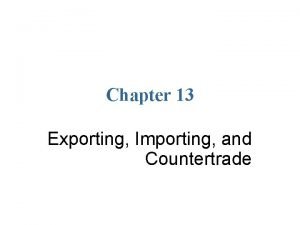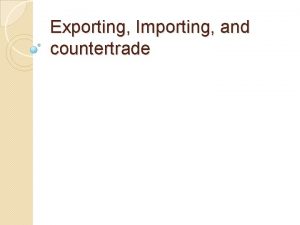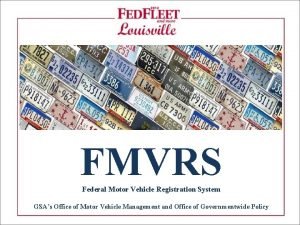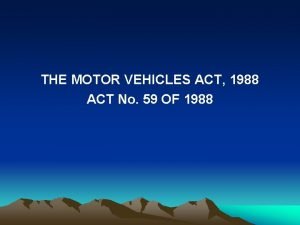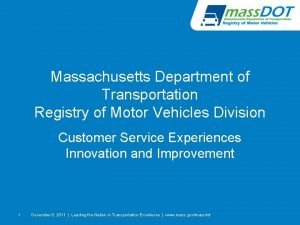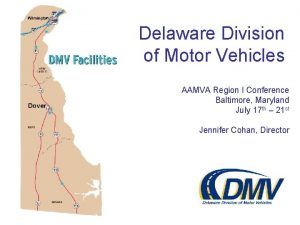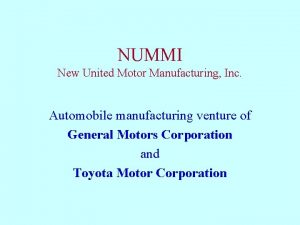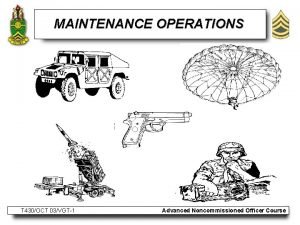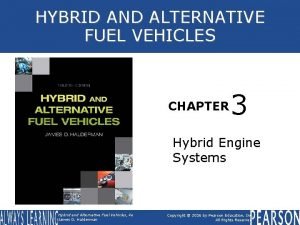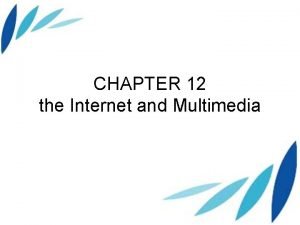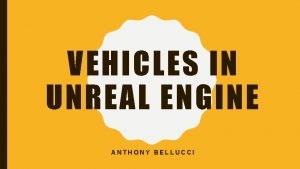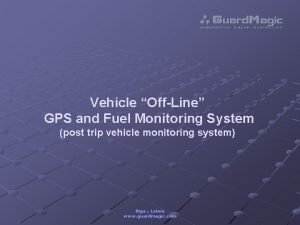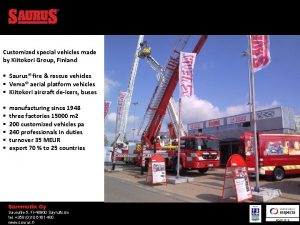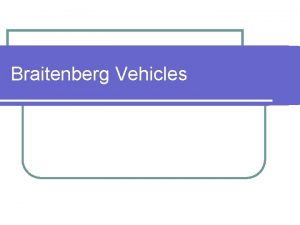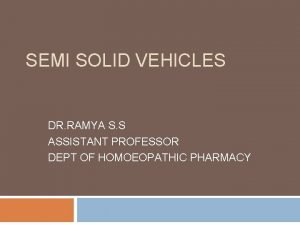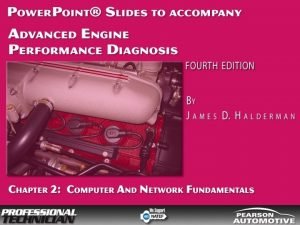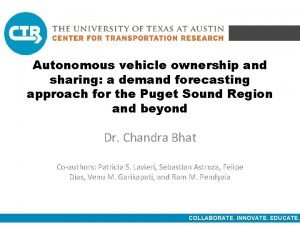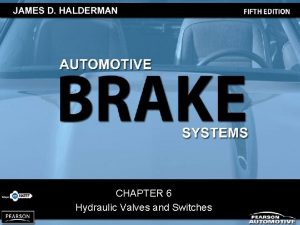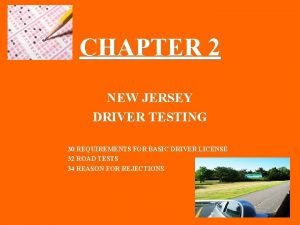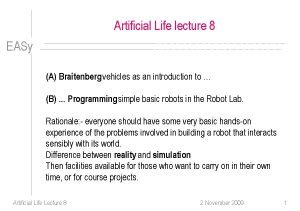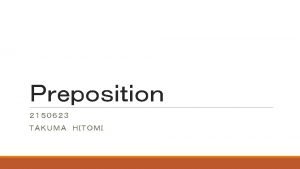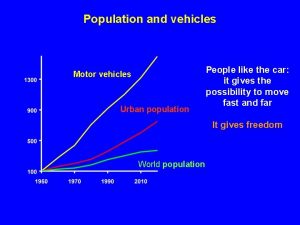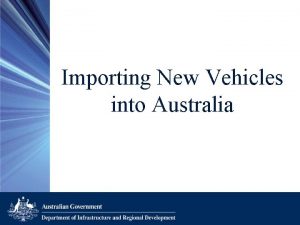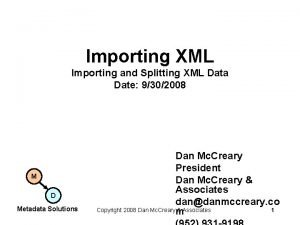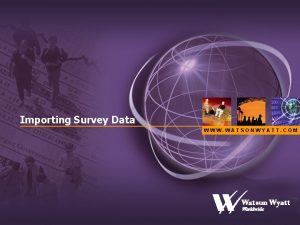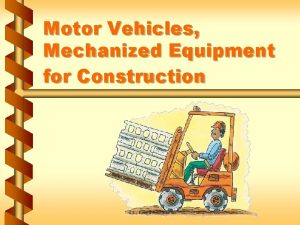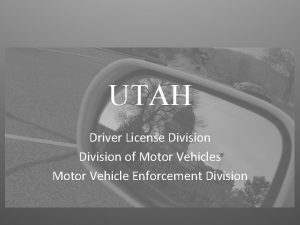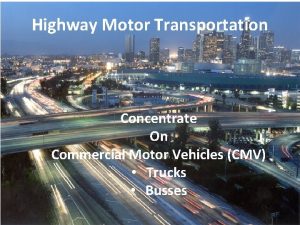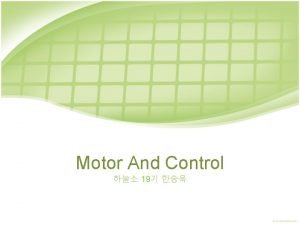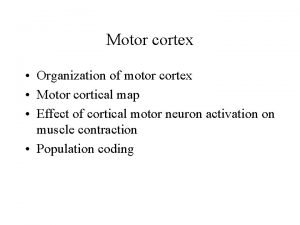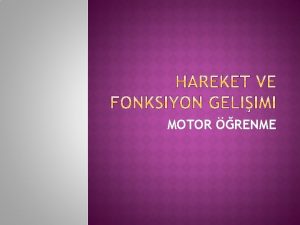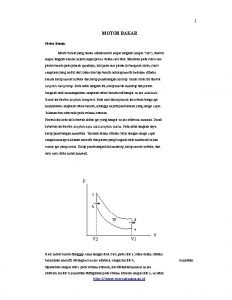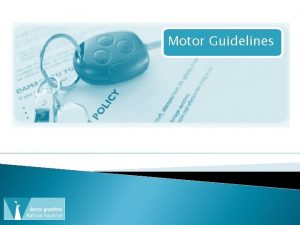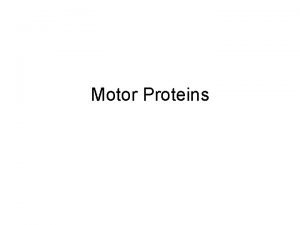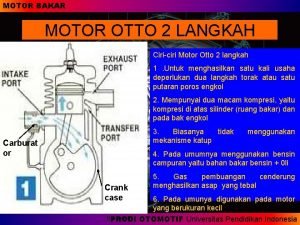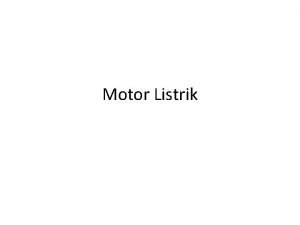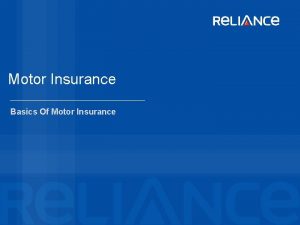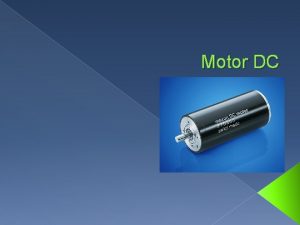Importing Motor Vehicles and Equipment into the United

































- Slides: 33

Importing Motor Vehicles and Equipment into the United States Andean Delegation Visit to the U. S. Department of Transportation December 5, 2016 Coleman Sachs, Chief, Import and Certification Division National Highway Traffic Safety Administration

NHTSA • A small agency in the U. S. Department of Transportation established in 1966 • Mission is to improve safety on nation’s highways and reduce fatalities and injuries associated with vehicle crashes • Issues the Federal motor vehicle safety standards (FMVSS) • Prescribe minimum safety performance requirements for motor vehicles and for certain items of motor vehicle equipment • Currently there are 64 FMVSS; 49 are vehicle standards; 15 apply to motor vehicle equipment 2

Statutory Prohibition • 49 U. S. C. 30112(a) provides that no person shall manufacture for sale, sell, offer for sale, introduce or deliver for introduction in interstate commerce, or import into the United States any motor vehicle or motor vehicle equipment manufactured on or after the date an applicable FMVSS takes effect unless the vehicle or equipment complies with the standard and is so certified by its manufacturer 3

Vehicle Importation; Declaration • HS-7 Declaration form must be filed with U. S. Customs and Border Protection (Customs) for motor vehicles and motor vehicle equipment items imported into the United States that are subject to the Federal motor vehicle safety, bumper, and theft prevention standards. • Form has 14 boxes, one of which must be checked to identify a lawful means for importing the vehicle or equipment item 4

5

Conforming Vehicles (Box 2 A) • Vehicles that are originally manufactured to conform to all applicable Federal motor vehicle safety, bumper, and theft prevention standards, and bear a label to that effect, permanently affixed by the original manufacturer, can be imported without restriction 6

Certification • Performed by the manufacturer and not NHTSA (no type approval) • Manifested by a label permanently affixed to the vehicle in a prescribed location • Identifies the manufacturer, the date of manufacture, the vehicle type • States that the vehicle complies with all applicable FMVSS in effect on the date of manufacture shown above 7

Sample Manufacturer Certification Label 8

Certification Requirements • The manufacturer must exercise “reasonable care” in certifying a vehicle or equipment item to an applicable standard. • If NHTSA suspects a noncompliance, it will ask the manufacturer to demonstrate how it exercised “reasonable care. ” • Tests are prescribed in many of the standards; these are NHTSA’s notice of what it will do to determine compliance. The manufacturer is free to demonstrate compliance by other means 9

Certification Requirements (Con’t) • If the manufacturer fails to demonstrate that it exercised “reasonable care” in certifying the vehicle or equipment item to the standard in question, it is subject to civil penalties • Penalties are currently set at $21, 000 per violation, up to a maximum penalty of $105, 000 for a related series of violations • A separate violation exists with respect to each vehicle or equipment item that does not comply 10

Procedural Requirements • • 11 Before exporting its products to the United States, the manufacturer of a conforming vehicle must: Identify itself and its products to NHTSA pursuant to 49 CFR Part 566 Submit VIN deciphering information to NHTSA pursuant to 49 CFR Part 565 Designate a U. S. resident as its agent for service of process pursuant to 49 CFR Part 551, Subpart D Consult NHTSA’s website at https: //vpic. nhtsa. dot. gov/ to learn whether these requirements have been met.

Nonconforming Vehicle Imports (Box 3) Vehicles under 25 years old that are not originally manufactured to conform to all applicable FMVSS can only be lawfully imported into the United States if: 1) They are determined eligible for importation by NHTSA, based on their capability of being modified to conform to all applicable FMVSS; and 2) They are imported by a registered importer (RI), or by a person who has a contract with an RI to bring the vehicle into compliance with all applicable FMVSS. 12

Import Eligibility Decisions • NHTSA makes import eligibility decisions on its own initiative, or on the basis of a petition submitted by a registered importer. • List of vehicles determined eligible can be found in 49 CFR Part 593 Appendix A or at www. nhtsa. gov/cars/rules/import • For other than Canadian-certified vehicles, decisions are made on a make, model and model year basis. • Owing to the similarity of the FMVSS and CMVSS, NHTSA makes blanket eligibility decisions for Canadian-certified vehicles. 13

Import Eligibility Decisions • To be determined eligible, the vehicle must either be: • Substantially similar to a vehicle of the same make, model, and model year that was certified by its original manufacturer for sale in the United States, or 14

Import Eligibility Decisions • If there is no substantially similar U. S. certified vehicle, the vehicle for which import eligibility is sought must have safety features that comply with, or are capable of being altered to comply with, all applicable FMVSS based on destructive test information or such other evidence that NHTSA decides is adequate 15

Nonconforming Vehicle Imports • If determined eligible for importation, the vehicle may only be imported by a registered importer (RI) or by a person who has a contract with an RI to conform the vehicle • The vehicle must be imported under bond to ensure that it is brought into conformity within 120 days of entry or is exported from or abandoned to the United States • The vehicle must not be salvage or reconstructed 16

Registered Importers • Must modify nonconforming vehicles so that they conform to all applicable standards within 120 days of entry • Must ensure that the vehicles are originally manufactured with FMVSS-compliant Tire Pressure Monitoring Systems • Must ensure that all outstanding recalls have been performed on the vehicles they import • Must assume the manufacturer’s responsibility to provide owners with notification and remedy in the event that a safety-related defect or noncompliance is determined to exist in the vehicle 17

Statement of Conformity • • • After it completes all modifications needed to confom an imported nonconforming vehicle to all applicable FMVSS, the Registered Importer submits to NHTSA a Statement of Conformity, supported by documentary and photographic evidence of the modifications made to achieve conformity. NHTSA refers to this as a “conformity package” Under the DOT conformance bond, the conformity package must be submitted to NHTSA no later than 120 days from the vehicle’s date of entry. If it is satisfied from its review of the conformity package that the vehicle has been successfully modified to conform, NHTSA will issue the RI a letter releasing the DOT conformance bond, which entitles the RI to release custody of the vehicle so that it can be titled and registered for on road use.

Temporary Imports (Box 7) • A vehicle that does not comply with all applicable Federal motor vehicle safety and bumper standards can be imported temporarily for purposes of research, investigations, demonstrations or training, or competitive racing events • A NHTSA permission letter is needed if the importer is not a manufacturer of motor vehicles certified to comply with all applicable FMVSS 19

Temporary Imports (cont’d) • NHTSA grants permission in annual increments for up to 3 years if duty is not paid on the vehicle, or for up to 5 years if duty is paid; the importer may request permission for the vehicle to remain in the US beyond 5 yrs. • Original manufacturers of US-certified vehicles do not need to furnish a permission letter from NHTSA, but they must supply a statement describing the use to be made of the vehicle including on-road use if contemplated. • Vehicle must be exported within 30 days from expiration of period for which importation is allowed 20

Off-Road Vehicles (Box 8) • NHTSA’s jurisdiction is limited to “motor vehicles, ” defined in 49 U. S. C. § 30102 as vehicles driven or drawn by mechanical power that are manufactured primarily for use on public streets, roads, and highways • Vehicles that are not manufactured for on-road use (such as dirt bikes, race cars, or ATVs) are not motor vehicles subject to the Federal motor vehicle safety, bumper, or theft prevention standards, but may be subject to jurisdiction of the Consumer Products Safety Commission and the EPA 21

Small Motor Scooters • Small motor scooters (such as pocket bikes, minichoppers, mini-ninjas) are regarded as “motor vehicles” that must comply with all applicable FMVSS if: • They are capable of a maximum speed of 20 miles per hour (32 km/hr) or greater, and • They are equipped with one or more of the following components needed for on-road use: turn signals, side marker lamps, stop lamps, mirrors. 22

ATV-type vehicles with on-road equipment • Regarded by NHTSA as a “motor vehicle” if: • It has a speed capability over 20 miles per hour, and • Is equipped with turn signals, stop lamps, mirrors, or other components needed for on-road use, and not needed in an off-road environment. • That is the case even if the vehicle is equipped with nubby tires and a sturdy suspension 23

Kit Cars • If a vehicle is shipped in a disassembled state, but with all components needed to assemble a complete vehicle, it is treated for importation purposes as a vehicle, and must be certified by its manufacturer (i. e. , the kit supplier) as complying with all applicable FMVSS, or 1) be determined eligible for importation by NHTSA and 2) be imported by a registered importer. 24

Kit Cars (Part 2) • If a vehicle is shipped without an engine and transmission, it is treated for importation purposes not as a motor vehicle, but instead as an assemblage of motor vehicle equipment items, and will be allowed to enter, provided all equipment covered by an FMVSS (i. e. , tires, rims, brake hoses, brake fluid, seat belt assemblies, lighting equipment, glazing) complies with the standard or is removed. 25

Exceptions • A nonconforming vehicle can be imported: • If it is at least 25 years old (Box 1) – If extensively rebuilt may not be eligible • If it is imported for export only and is so labeled (Box 4) • By a nonresident of the U. S. , for personal use, for up to one year (Box 5) • By foreign diplomatic or military personnel on assignment in the U. S. (Box 6 and 12) 26

Vehicle Import Statistics B ‘ 01 O X ‘ 02 ‘ 03 ‘ 04 ‘ 05 ‘ 06 ‘ 07 ‘ 08 ‘ 09 ‘ 10 ‘ 11 ‘ 12 ‘ 13 ‘ 14 ’ 15 2 1. 3 m A 1. 9 m 2. 3 m 2. 7 m 3. 9 m 4. 4 m 4 m 3. 7 m 3. 2 m 4. 6 m 5. 0 m 5. 6 m 5. 8 m 6. 5 m 6. 9 m 3 200 K 212 K 97 K 43 K 13 K 8 K 6 K 11 K 18 K 23 K 30 K 36 K 74 K 216 K 8 41 K 55 K 79 K 95 K 88 K 105 K 122 K 175 K 99 K 153 K 192 K 326 K 207 K 335 K 421 K 27

Equipment Standards • • 28 Certain of the standards establish minimum safety performance requirements for items of motor vehicle equipment. The equipment items that are subject to these standards are: – tires – rims – brake hoses – brake fluid – seat belt assemblies – lighting equipment – glazing – child seats – motorcycle helmets – compressed natural gas containers, – triangular reflective warning devices, – rear impact guards for trailers, – platform lift systems for the mobility impaired.

Importation Restrictions • Flat prohibition on the importation of an equipment item, new or used, that is subject to a standard, unless the equipment is manufactured to the standard and is so certified • Nonconforming vehicles can be imported provided they are determined eligible for importation and are imported by a registered importer 29

Safety of Imported Products; Best Importer Practices • Recommendend by The Interagency Working Group on Import Safety in November 2007 Action Plan • NHTSA published its Recommended Best Importer Practices on December 24, 2008 at 73 FR 79297 30

NHTSA’s Recommended Best Importer Practices • • 31 Convey to Importers their Obligations under Statutes and Regulations administered by NHTSA Urge Importers to Exercise Great Care in Selecting Foreign Manufacturers Recommend that Importers Inspect Foreign Manufacturing Facilities Recommend that Importers Inspect Goods Before They Are Exported to or Distributed in the United States Recommend that Importers Identify the Origin of Products to be Imported Urge Importers to Establish a Consumer Service Program Recommend that Importers Contact NHTSA Concerning Self-Certification, Compliance, and Defect Issues

Internet Resources • For information on NHTSA’s importation program: www. nhtsa. gov/cars/rules/import. Information on that site includes a detailed list of answers to frequently asked questions. • For a quick reference guide to the FMVSS: www. nhtsa. gov/cars/rules/standards. • To access the full text of the FMVSS: http: //www. access. gpo. gov/nara/cfr/waisidx_07/49 cfr 571_07. ht ml • For FMVSS test procedures: http: //www. nhtsa. gov/portal/site/nhtsa/menuitem. b 166 d 5602714 f 9 a 73 baf 3210 dba 046 a 0/ • A brochure for new motor vehicle or equipment manufacturers can be downloaded at: www. nhtsa. gov/cars/rules/maninfo. 32

Contacts • • Import and Certification Division tel: (202) 366 -5291 fax: (202) 493 -0073 e-mail: importertification@dot. gov Coleman Sachs (Division Chief) tel: (202) 366 -3151 e-mail: coleman. sachs@dot. gov 33
 Offset counter trade
Offset counter trade Insourching
Insourching The great promise of exporting is that
The great promise of exporting is that Poem about momentum and impulse
Poem about momentum and impulse Nascar motors assembles and sells
Nascar motors assembles and sells Fmvrs license plate
Fmvrs license plate Gso regulations
Gso regulations Motor vehicles act 1988
Motor vehicles act 1988 Massachusetts department of motor vehicle
Massachusetts department of motor vehicle Delaware division of motor vehicles
Delaware division of motor vehicles Motor unit
Motor unit New united motor manufacturing
New united motor manufacturing Da form 2401
Da form 2401 Fuel pressure regulator diagram
Fuel pressure regulator diagram Plugins and delivery vehicles in multimedia
Plugins and delivery vehicles in multimedia Three phase synchronous generator
Three phase synchronous generator Pony motor starting synchronous motor
Pony motor starting synchronous motor Motor parts name
Motor parts name Pony motor starting synchronous motor
Pony motor starting synchronous motor Unreal engine vehicle movement
Unreal engine vehicle movement Gps fuel monitoring system
Gps fuel monitoring system Additives used in monophasic liquid dosage form
Additives used in monophasic liquid dosage form Consumer oriented vs trade-oriented sales promotion
Consumer oriented vs trade-oriented sales promotion Kiitokori special vehicles
Kiitokori special vehicles Valentino braitenberg vehicles
Valentino braitenberg vehicles Semi solid vehicles
Semi solid vehicles All obdii vehicles use what type of read-only memory?
All obdii vehicles use what type of read-only memory? Forecasting demand for autonomous vehicles
Forecasting demand for autonomous vehicles Autonomous car ppt
Autonomous car ppt Gordon stein general dynamics
Gordon stein general dynamics Which brake fluid valves are found on today's vehicles
Which brake fluid valves are found on today's vehicles Nj road test requirements
Nj road test requirements Braitenberg vehicles simulation
Braitenberg vehicles simulation Prepositions vehicles
Prepositions vehicles
